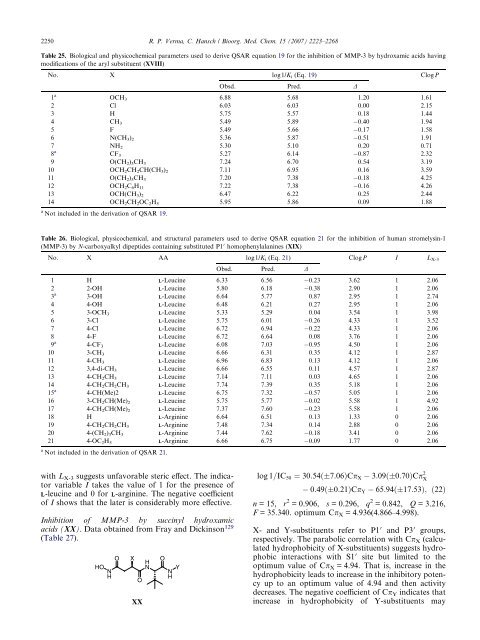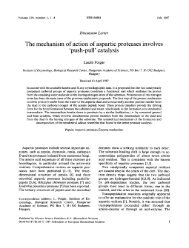Matrix metalloproteinases (MMPs): Chemical–biological functions ...
Matrix metalloproteinases (MMPs): Chemical–biological functions ...
Matrix metalloproteinases (MMPs): Chemical–biological functions ...
You also want an ePaper? Increase the reach of your titles
YUMPU automatically turns print PDFs into web optimized ePapers that Google loves.
2250 R. P. Verma, C. Hansch / Bioorg. Med. Chem. 15 (2007) 2223–2268<br />
Table 25. Biological and physicochemical parameters used to derive QSAR equation 19 for the inhibition of MMP-3 by hydroxamic acids having<br />
modifications of the aryl substituent (XVIII)<br />
No. X log1/Ki (Eq. 19) ClogP<br />
Obsd. Pred. D<br />
1 a<br />
OCH3 6.88 5.68 1.20 1.61<br />
2 Cl 6.03 6.03 0.00 2.15<br />
3 H 5.75 5.57 0.18 1.44<br />
4 CH35.49 5.89 0.40 1.94<br />
5 F 5.49 5.66 0.17 1.58<br />
6 N(CH3)2 5.36 5.87 0.51 1.91<br />
7<br />
8<br />
NH25.30 5.10 0.20 0.71<br />
a<br />
CF3 5.27 6.14 0.87 2.32<br />
9 O(CH2)3CH3 7.24 6.70 0.54 3.19<br />
10 OCH2CH2CH(CH3)2 7.11 6.95 0.16 3.59<br />
11 O(CH2) 5CH3 7.20 7.38 0.18 4.25<br />
12 OCH2C6H11 7.22 7.38 0.16 4.26<br />
13 OCH(CH3)2 6.47 6.22 0.25 2.44<br />
14 OCH2CH2OC2H5 5.95 5.86 0.09 1.88<br />
a<br />
Not included in the derivation of QSAR 19.<br />
Table 26. Biological, physicochemical, and structural parameters used to derive QSAR equation 21 for the inhibition of human stromelysin-1<br />
(MMP-3) by N-carboxyalkyl dipeptides containing substituted P10 homophenylalanines (XIX)<br />
No. X AA log1/Ki (Eq. 21) ClogP I LX-3<br />
Obsd. Pred. D<br />
1 H L-Leucine 6.33 6.56 0.23 3.62 1 2.06<br />
2 2-OH L-Leucine 5.80 6.18 0.38 2.90 1 2.06<br />
3 a<br />
3-OH L-Leucine 6.64 5.77 0.87 2.95 1 2.74<br />
4 4-OH L-Leucine 6.48 6.21 0.27 2.95 1 2.06<br />
5 3-OCH3 L-Leucine 5.33 5.29 0.04 3.54 1 3.98<br />
6 3-Cl L-Leucine 5.75 6.01 0.26 4.33 1 3.52<br />
7 4-Cl L-Leucine 6.72 6.94 0.22 4.33 1 2.06<br />
8 4-F L-Leucine 6.72 6.64 0.08 3.76 1 2.06<br />
9 a<br />
4-CF3 L-Leucine 6.08 7.03 0.95 4.50 1 2.06<br />
10 3-CH3 L-Leucine 6.66 6.31 0.35 4.12 1 2.87<br />
11 4-CH3 L-Leucine 6.96 6.83 0.13 4.12 1 2.06<br />
12 3,4-di-CH3 L-Leucine 6.66 6.55 0.11 4.57 1 2.87<br />
13 4-CH2CH3 L-Leucine 7.14 7.11 0.03 4.65 1 2.06<br />
14<br />
15<br />
4-CH2CH2CH3 L-Leucine 7.74 7.39 0.35 5.18 1 2.06<br />
a<br />
4-CH(Me)2 L-Leucine 6.75 7.32 0.57 5.05 1 2.06<br />
16 3-CH2CH(Me)2 L-Leucine 5.75 5.77 0.02 5.58 1 4.92<br />
17 4-CH2CH(Me)2 L-Leucine 7.37 7.60 0.23 5.58 1 2.06<br />
18 H L-Arginine 6.64 6.51 0.13 1.33 0 2.06<br />
19 4-CH2CH2CH3 L-Arginine 7.48 7.34 0.14 2.88 0 2.06<br />
20 4-(CH2)3CH3 L-Arginine 7.44 7.62 0.18 3.41 0 2.06<br />
21 4-OC2H5 L-Arginine 6.66 6.75 0.09 1.77 0 2.06<br />
a Not included in the derivation of QSAR 21.<br />
with L X-3 suggests unfavorable steric effect. The indicator<br />
variable I takes the value of 1 for the presence of<br />
L-leucine and 0 for L-arginine. The negative coefficient<br />
of I shows that the later is considerably more effective.<br />
Inhibition of MMP-3 by succinyl hydroxamic<br />
acids (XX). Data obtained from Fray and Dickinson 129<br />
(Table 27).<br />
HO NH<br />
O<br />
X<br />
O<br />
XX<br />
H<br />
N<br />
O<br />
Y<br />
N<br />
H<br />
log 1=IC50 ¼ 30:54ð 7:06ÞCpX 3:09ð 0:70ÞCp 2<br />
X<br />
0:49ð 0:21ÞCpY 65:94ð 17:53Þ; ð22Þ<br />
n = 15, r 2 = 0.906, s = 0.296, q 2 = 0.842, Q = 3.216,<br />
F = 35.340. optimum CpX = 4.936(4.866–4.998).<br />
X- and Y-substituents refer to P1 0 and P3 0 groups,<br />
respectively. The parabolic correlation with Cp X (calculated<br />
hydrophobicity of X-substituents) suggests hydrophobic<br />
interactions with S1 0 site but limited to the<br />
optimum value of Cp X = 4.94. That is, increase in the<br />
hydrophobicity leads to increase in the inhibitory potency<br />
up to an optimum value of 4.94 and then activity<br />
decreases. The negative coefficient of Cp Y indicates that<br />
increase in hydrophobicity of Y-substituents may



